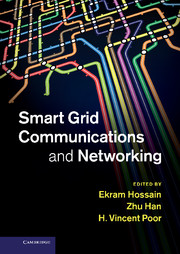Book contents
- Frontmatter
- Contents
- List of contributors
- Preface
- Part I Communication architectures and models for smart grid
- Part II Physical data communications, access, detection, and estimation techniques for smart grid
- Part III Smart grid and wide-area networks
- 9 Networking technologies for wide-area measurement applications
- 10 Wireless networks for smart grid applications
- Part IV Sensor and actuator networks for smart grid
- Part V Security in smart grid communications and networking
- Part VI Field trials and deployments
- Index
9 - Networking technologies for wide-area measurement applications
from Part III - Smart grid and wide-area networks
Published online by Cambridge University Press: 05 January 2013
- Frontmatter
- Contents
- List of contributors
- Preface
- Part I Communication architectures and models for smart grid
- Part II Physical data communications, access, detection, and estimation techniques for smart grid
- Part III Smart grid and wide-area networks
- 9 Networking technologies for wide-area measurement applications
- 10 Wireless networks for smart grid applications
- Part IV Sensor and actuator networks for smart grid
- Part V Security in smart grid communications and networking
- Part VI Field trials and deployments
- Index
Summary
Introduction
A wide-area measurement system (WAMS) consists of advanced measurement technology, the latest communication network infrastructure, and integrated operational framework. The supervisory control and data acquisition (SCADA) infrastructure for energy-management system (EMS) has been widely used in power systems for a long time. Some of the functionalities of an EMS are system state monitoring, tie-line bias control, and economic dispatch [1]. However, in recent years, various deficiencies of the existing SCADA-based EMS (such as quasi-steady-state calculation, non-synchronized data acquisition, and relatively low data transmission rate) have been pointed out. These defects make it impossible to sample the global state of a power system in real time. As more and more wide-area blackouts are reported, it is clear that acquiring real-time or wide-area state information would be needed in the future. The state information in terms of phasors of voltages and currents from a distributed wide area in real time is therefore critical for avoiding large-area disturbances by effecting wide-area control based on wide-area measurements.
The main enabler of WAMS is phasor measurement unit (PMU) technology. With the innovation of PMU, the problem of measuring the phasor quantities simultaneously from a wide area of distributed substations, also called ‘synchrophasor’, has been solved. At present, the PMU technology is one of the essential enablers for WAMS. It utilizes the availability of high-precision synchronized clock sources – extracted from global positioning system (GPS) receivers and samples the instantaneous analogue – quantities of voltage and current magnitudes and phase angles.
Information
- Type
- Chapter
- Information
- Smart Grid Communications and Networking , pp. 205 - 233Publisher: Cambridge University PressPrint publication year: 2012
Accessibility standard: Unknown
Why this information is here
This section outlines the accessibility features of this content - including support for screen readers, full keyboard navigation and high-contrast display options. This may not be relevant for you.Accessibility Information
- 3
- Cited by
